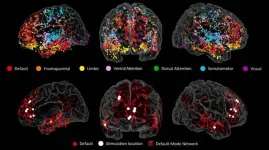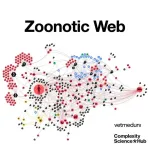(Press-News.org) Have you ever had the solution for a tough problem suddenly hit you when you’re thinking about something entirely different? Creative thought is a hallmark of humanity, but it’s an ephemeral, almost paradoxical ability, striking unexpectedly when it’s not sought out.
And the neurological source of creativity—what’s going on in our brains when we think outside the box—is similarly elusive.
But now, a research team led by a University of Utah Health researcher and based in Baylor College of Medicine has used a precise method of brain imaging to unveil how different parts of the brain work together in order to produce creative thought.
Their findings published in BRAIN on June 18.
The new results could ultimately help lead to interventions that spark creative thought or aid people who have mental illnesses that disrupt these regions of the brain.
Outside the bo
Higher cognitive processes like creativity are especially hard to study. “Unlike motor function or vision, they’re not dependent on one specific location in the brain,” says Ben Shofty, MD, PhD, assistant professor of neurosurgery in the Spencer Fox Eccles School of Medicine and senior author on the paper. “There’s not a creativity cortex.”
But there’s evidence that creativity is a distinct brain function. Localized brain injury caused by stroke can lead to changes in creative ability—both positive and negative. That discovery suggests that narrowing down the neurological basis of creativity is possible.
Shofty suspected that creative thought might rely strongly on parts of the brain that are also activated during meditation, daydreaming, and other internally focused types of thinking. This network of brain cells is the default mode network (DMN), so called because it’s associated with the “default” patterns of thought that happen in the absence of specific mental tasks. “Unlike most of the functions that we have in the brain, it's not goal-directed,” Shofty says. “It's a network that basically operates all the time and maintains our spontaneous stream of consciousness.”
The DMN is spread out across many dispersed brain regions, making it more difficult to track its activity in real time. The researchers had to use an advanced method of brain activity imaging to understand what the network was doing moment-to-moment during creative thought. In a strategy most commonly used to pinpoint the location of seizures in patients with severe epilepsy, tiny electrodes are implanted in the brain to precisely track the electrical activity of multiple brain regions.
Participants in the study were already undergoing this kind of seizure monitoring, which meant that the research team could also use the electrodes to measure brain activity during creative thinking. This provided a much more detailed picture of the neural basis of creativity than researchers had been able to capture before. “We could see what's happening within the first few milliseconds of attempting to perform creative thinking,” Shofty says.
Two steps toward originality
The researchers saw that during a creative thinking task in which participants were asked to list novel uses for an everyday item, like a chair or a cup, the DMN lit up with activity first. Then, its activity synchronized with other regions in the brain, including ones involved in complex problem-solving and decision-making. Shofty believes this means that creative ideas originate in the DMN before being evaluated by other regions.
What’s more, the researchers were able to show that parts of the network are required specifically for creative thought. When the researchers used the electrodes to temporarily dampen the activity of particular regions of the DMN, people brainstormed uses for the items they saw that were less creative. Their other brain functions, like mind wandering, remained perfectly normal.
Eleonora Bartoli, PhD, assistant professor of neurosurgery at Baylor College of Medicine and co-first author on the paper, explains that this result shows that creativity isn’t just associated with the network but fundamentally depends on it. “We moved beyond correlational evidence by using direct brain stimulation,” she says. “Our findings highlight the causal role of the DMN in creative thinking.”
The activity of the network is changed in several disorders, such as ruminative depression, in which the DMN is more active than normal, possibly related to increased dwelling on negative internally directed thoughts. Shofty says that a better understanding of how the network operates normally may lead to better treatments for people with such conditions.
By characterizing the brain regions involved in creative thought, Shofty hopes to ultimately inspire interventions that can help spark creativity. “Eventually, the goal would be to understand what happens to the network in such a way that we can potentially drive it toward being more creative.”
# # #
The study published in BRAIN on June 18th as “Default mode network electrophysiological dynamics and causal role in creative thinking.” This research was supported by the McNair Foundation and the National Institute of Mental Health (grant number R01-MH127006.)
This work was a collaboration between researchers at University of Utah Health, Baylor College of Medicine, and Technion—Israel Institute of Technology.
END
Study pinpoints origins of creativity in the brain
2024-07-15
ELSE PRESS RELEASES FROM THIS DATE:
Breakthrough wildlife tracking technology that adheres to fur delivers promising results from trials on wild polar bears
2024-07-15
TORONTO, July 15, 2024 – Studying polar bears just became a lot easier with new “burr on fur” trackers which confirmed scientists’ belief that subadult and adult males spend most of their time on land lazing around, conserving energy until the ice returns.
A multi-institutional research team led by York University and including the University of Alberta, Environment and Climate Change Canada, Manitoba Sustainable Development, Ontario Ministry of Natural Resources and Forestry, and Polar Bears International, used three ...
Study unveils complexity of zoonotic transmission chains
2024-07-15
[Vienna, July 11 2024] — Researchers from the Complexity Science Hub and the University of Veterinary Medicine Vienna have dissected the complex interactions involved in zoonoses, which affect worldwide over two billion people annually. They introduce the concept of a "zoonotic web," a detailed network representation of the relationships between zoonotic agents, their hosts, vectors, food sources, and the environment.
"Zoonotic diseases, which can be transmitted between animals and humans, are a significant public health concern, and our study highlights the importance of a holistic approach to understanding and managing these ...
30-year risk of cardiovascular disease may help inform blood pressure treatment decisions
2024-07-15
Research Highlights:
A comparison of two tools for calculating cardiovascular disease risk found that if only the current 10-year risk thresholds are applied, fewer adults may be recommended for blood pressure-lowering medication. The tools, The American Heart Association’s new PREVENTTM tool and the Pooled Cohort Equations, were applied to a cross-sectional sample of adults from NHANES datasets with stage 1 hypertension who did not report having CVD.
PREVENT can additionally be used to calculate an individual’s 30-year risk ...
Off-the-shelf wearable trackers provide clinically-useful information for patients with heart disease
2024-07-15
Monitoring of heart rate and physical activity using consumer wearable devices was found to have clinical value for comparing the response to two treatments for atrial fibrillation and heart failure.
The study published in Nature Medicine examined if a commercially-available fitness tracker and smartphone could continuously monitor the response to medications, and provide clinical information similar to in-person hospital assessment.
The wearable devices, consisting of a wrist band and connected smartphone, collected a vast amount of data on the response to two different medications prescribed ...
Visualizing addiction: How new research could change the way we fight the opioid epidemic
2024-07-15
New research from a Max Planck Florida Institute for Neuroscience researcher could transform how we understand the way opioids affect the brain. Despite significant discussion surrounding the ongoing opioid crisis, current understanding of how opioids function in the brain is quite limited. This is primarily due to challenges in observing and measuring opioid effects in the brain in real-time. However, a recent technological breakthrough, led by Dr. Lin Tian and her research team and collaborators, recently published in Nature Neuroscience, has overcome these limitations and is set to transform how scientists study opioid signaling ...
Caught in the actinium
2024-07-15
The element actinium was first discovered at the turn of the 20th century, but even now, nearly 125 years later, researchers still don’t have a good grasp on the metal’s chemistry. That’s because actinium is only available in extremely small amounts and working with the radioactive material requires special facilities. But to improve emerging cancer treatments using actinium, researchers will need to better understand how the element binds with other molecules.
In a new study led by the Department of Energy’s Lawrence Berkeley National Laboratory (Berkeley Lab), ...
Out-of-pocket medical costs are substantial and rising for privately insured men with abnormal prostate cancer screening results who require further diagnostic testing
2024-07-15
Prostate-specific antigen (PSA) screening aims to identify men who may harbor potentially lethal prostate cancer, and those with high PSA results often require more extensive (and expensive) diagnostic testing to establish a diagnosis. New research reveals that the out-of-pocket costs for such additional tests are substantial, common, and rising. The findings are published by Wiley online in CANCER, a peer-reviewed journal of the American Cancer Society.
Abnormal screening tests (i.e., elevated PSA) warrant ...
A new method for sustainable synthesis of acetylene from carbon dioxide
2024-07-15
Since its discovery, in 1836, acetylene has emerged as an essential chemical compound in industry, widely used as a chemical building block and fuel. It has applications in the raw material for resins, such as vinyl chloride, welding gas, and illumination. Recent developments aimed at reducing the dependence on petroleum feedstocks have shown that acetylene is a promising platform molecule for producing various base chemicals. Additionally, polyacetylene, a crucial semiconducting material, is made from acetylene. Currently, acetylene is mainly produced through two methods: ...
Localization of anion exchange membrane water electrolysis is a step forward!
2024-07-15
A research team led by Dr. Sung Mook Choi of the Korea Institute of Materials Science, a government-funded research institute under the Ministry of Science and ICT, has developed a one-step electrode fabrication process for the first time in South Korea. This process produces electrodes, a key component of anion exchange membrane water electrolysis, directly from raw materials to a mass-producible level. The team successfully applied this process to a commercial-scale stack of anion exchange membrane water ...
Atomically controlled MXenes enable cost-effective green hydrogen production
2024-07-15
137 countries around the world have signed a "net-zero" climate change agreement to end fossil fuel use and achieve zero carbon emissions by 2050. Hydrogen is being touted as the next green energy source because it emits only water and oxygen when utilized as an energy source. Hydrogen production methods are divided into gray hydrogen, blue hydrogen, and green hydrogen depending on the energy source and carbon emissions. Among them, green hydrogen production method is the most eco-friendly method that produces hydrogen without carbon emissions by electrolyzing water using green energy.
A research team led by Dr. ...








